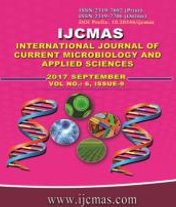


 National Academy of Agricultural Sciences (NAAS)
National Academy of Agricultural Sciences (NAAS)

|
PRINT ISSN : 2319-7692
Online ISSN : 2319-7706 Issues : 12 per year Publisher : Excellent Publishers Email : editorijcmas@gmail.com / submit@ijcmas.com Editor-in-chief: Dr.M.Prakash Index Copernicus ICV 2018: 95.39 NAAS RATING 2020: 5.38 |
Staphylococcus epidermidis is a common commensal of the skin and mucous membranes of humans. However, it is a common cause of nosocomial infection especially infection associated with the insertion of biomedical devices. Glycans have been shown to mediate vast majority of biological processes and its alterations have been reported to be used as biomarkers and applied in diagnosis of malignancies and infections. The absolute mean Optical Density (OD450nm) of the biofilm was calculated as 0.248± 0.044SD and the biofilm was observed to strongly adhere to the microtitre plate surface. The biofilm growth curve peaks at 2hrs with a mean OD450nm of 0.385; at 30 minutes and 4hrs growth, mean OD450nm were 0.365 and 0.383 respectively and drastically drops to 0.248 at 24hrs. A panel of 11 biotinylated lectins was used to detect any alterations in glycosylation of the glycans expressed by of S. epidermidis RP62A (ATCC 35984). Glycans’ expression varies with time and most glycans showed strong expression at 2hrs of incubation except N-acetyl galactosamine (GalNAc), which showed strong expression at 30 minutes. Glycosylation inhibitors such as Neuraminidase, Cytidine 5’- monophospho-N- acetylneuraminic acid sodium salt (CMP-NANA), Sialic acid aldolase and 1M Hydrochloric acid were used to prevent biofilm establishment and development and their effects evaluated using toluidine blue stain and lectin screening. The glycosylation inhibitors showed remarkable 80% reduction in Extracellular Polysaccharides (EPS) production and the expression of glycans in comparison with the control, and were most effective at 2hrs relative to 0hr and 4hrs of incubation except 1M HCl, which was effective at 0hr compared to other times of incubation. This study reveals new strategies of using glycosylation inhibitors to prevent biofilm formation during implant of medical devices.
 |
 |
 |
 |
 |